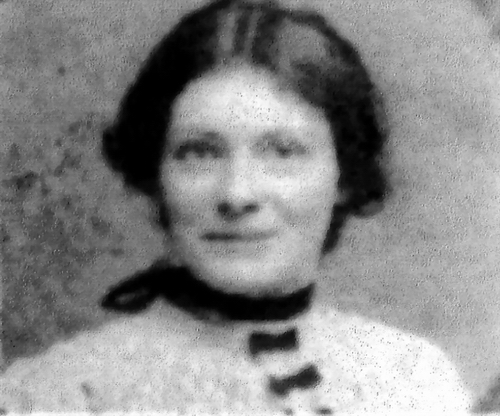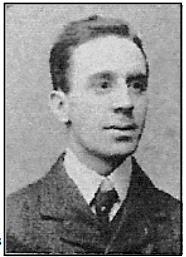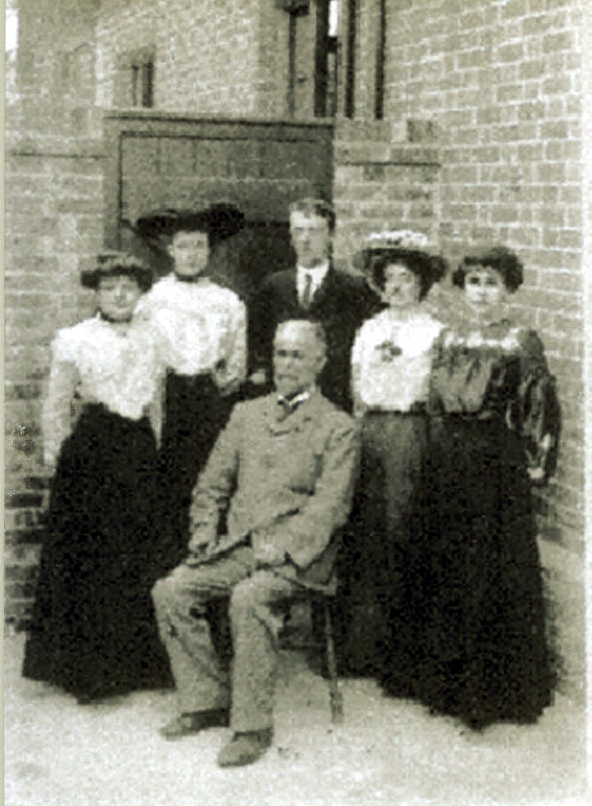
Dersingham Folk
All Rights reserved
Site by Mike Strange

Many of us have looked with pleasure at the postcards that show this village as it was in days gone by. From the sepia images men, women and children from times past, going about their daily business stare at the camera. We can glimpse this one fleeting moment in the lives of people we may never know but who walked this village in some cases over a hundred years ago.
Although parts of the village are hardly changed there are areas so altered that it is only through these cards that we can ever know what they once looked like. We owe a great debt to the photographers who walked the streets and recorded what they saw. The name Ralph will be very familiar to anyone who has looked at the cards of this village.
On 12th October 1901 Ann [aka Annie] Rachel Mann, the oldest daughter of Henry and Rachel Mann of Heath House married Frederick William Ralph in the parish church of Islington London.


Frederick was born in Dersingham on the 15th March 1872. [See our article about the Ralph family here] He grew up to follow in his father’s footsteps and became a photographer. The Ralph’s had photographic studios in Dersingham and Hunstanton. The firm had a Royal Warrant of Approval and they took numerous photos of the Royals on all sorts of occasions at Sandringham. In 1896 Frederick Ralph is listed in the Directories as “Usher and Photographer” residing at Victoria Cottage Dersingham. I am not certain what the term Usher implies but in one photograph of Frederick he has a Royal Crown on his tie.
Unfortunately not a lot is known about Frederick, as he seems to have disappeared from the family records. He did attend the funeral of his father-in-law Henry in 1917 and the Directories of 1922 record Frederick Ralph Photographer at Heath Road. Frederick and Ann had eight children, the last two being born sometime after 1916. At some point Frederick’s house was cleared and it is said that hundreds of glass negatives were destroyed. If this is true we can only speculate on the treasure that has been lost.
A Walter Ralph was still recorded as a photographer here well into the 1930’s. We owe Annie’s husband and his family a debt of gratitude for recording so much of this village for posterity.
Annie’s sister Alice Lucy who was born on 13 March 1883 grew up to become a much-loved member of this community. She trained as a teacher and took up her first post in or near Wisbech. Alice was a pupil teacher in the 1901 census lodging with a Mrs Jane Plant at 7 Silver Street. From there she used to cycle the 25 miles home to Dersingham each weekend.
Perhaps this journey along the non-too smooth roads of the time on a bike of that era was too demanding as after a while Alice took up the position of teacher of infants at the Dersingham School. Certainly by 1911 she was back living with her parents in Dersingham and now an Elementary Teacher.
Alice is one of the teachers with Mr Firth, headmaster; we would be delighted to know which is Alice and who the others were. Alice sadly died on 6 January 1924 in the Norfolk Mental Hospital, Thorpe St Andrew, Norwich; her address was given as Heath House, Dersingham.
This school at the bottom of Doddshill was built in 1875 on the land given to the village by the Prince of Wales. Mr. Alfred Firth had been appointed the headmaster when the school first opened. He was born in 1851 in Kenninghall so came to Dersingham as a young man of 24.

Before coming to Dersingham he had been at Castle Rising from 1871 to 1875 and in those early days of his career had to attend lectures with other apprentice teachers from 6.15 to 7.15 each morning. He then taught six or more hours a day with long preparation of lessons in the evening. Castle Rising then was the only school in the near neighbourhood under a master. Boys walked from Sandringham, West Newton, Dersingham, Babingley, Wolferton, North and South Wootton, Roydon and Hillington and, according to Mr. Firth, were usually punctual. Sometimes at the end of the school day one of the boys, a farmer’s son, commandeered from home a small cart with a pony. The loading up of the boys was great fun especially when some of the locals tried to get on. They were evicted with great ceremony before the laden cart set off. One fears for the pony!
Alfred came to Dersingham with his wife Susannah, daughter Emma and son Alfred Richard. A second son Frederick was born here in 1880. The Directory of 1890 records Emma Firth as a schoolmistress alongside her father. Mr. Firth ran the Dersingham Sunday School for 25 years and the well-attended Evening Classes. One report in the Parish Magazine records that the Evening School was open three evenings a week. There was instruction in Agriculture, Mensuration and Drawing. The highest number present was 23 and “the lads are fairly regular and are attentive.” He presided at the opening of the new church organ when the service was attended by King Edward, Queen Alexandra and all the royal children. He also served as clerk to the trustees of Dersingham United Charities and was Chairman of the parish Council. He served as a Churchwarden at a time when they had many functions including one of being trustee of the common lands. The choice of the people’s warden was often decided on questions outside church matters. The election address of one candidate one year was, “You put me on, and I’ll keep the donkeys off your gardens.” He was duly elected and although he retired at the end of that year he had made all the common fences secure thus saving many gardens from the four-legged raiders. So this was the headmaster when Alice joined the school. A family photo shows her with her colleagues standing behind Mr. Firth. The young man standing with her could possibly be the Mr. Walden who is mentioned in the school logbook in 1914. “Mr. Walden on military service having joined the RAMS”.
It is certain that Alice would have known Mr. Firth’s eldest son Alfred Richard known in the village as Dick. He was a most successful pupil at Dersingham and the King Edward VII Grammar School in Lynn. He graduated from London University and became Vice-Consul in Kobe, Japan. In 1916 aged just 26 he died after an operation for appendicitis. The whole village mourned his passing and a memorial window was erected in the church. Mr. Firth retired in 1915 after 52 years as a teacher but continued to serve the village until his death in 1932. Elton Wheeler, who I believe lived in the large house Park View by the newsagents, took his place. In 1923 aged 40 Alice became unwell and after a short illness she died a few days after Christmas. Her obituary in the Lynn News reflects the shock felt by the village at her unexpected passing. There was a large attendance at her funeral. Led by Mrs. Wheeler, the headmaster’s wife, “the little scholars of her class followed her to her last resting place carrying beautiful flowers in token of their affection.” Mr. Firth accompanied the hymns on the organ. A concert and a play were organised to raise funds for a memorial. This took the form of a wooden screen with an engraved brass plate that was placed somewhere in the school. Unfortunately it seems to have been removed during a “modernisation” but perhaps some villagers remember seeing it.
Ruth Mann the fifth daughter of Henry and Rachel married Herbert Cross at Hunstanton in 1920. They had six children and two of their sons Alan and Eric gave extensive interviews during the Millennium project. The Cross family lived at the end of The Drift and both men remembered a happy childhood in the village. There used to be a rubbish dump situated in the area just behind where the roundabout at the entry to the village now is. I remember going there with the household waste and walking round to the sand quarry close by. There by the steep sandy cliffs I used to watch the sand martins as they swooped around and flew with such uncanny accuracy straight into the burrows in the cliffs. Alan Cross recalled.”We spent a lot of time scavenging around the dump for anything we could make a good cart from. We used to go down the hills on the common.” There was very little traffic in those days and Alan remembered that it was a Sunday occupation for many villagers to go to the common. “There were six or eight seats there and most would be occupied on a Sunday. To watch what traffic was coming along was quite an event. Many would break down and a break down was an interesting event.”
There used to be several garages in the village. I have advertisements for Eric Hyner & Co. Ltd. at The Sandringham Garage. Charles Whisker ran the Heath Garage. R. Isherwood ran the Red Pumps Garage, which still stands next to Beck House. Mrs. Isherwood was a member of the Beck family and they lived next to the garage at Blackheath Lodge (now Beck House). J. Twaite ran The Garage that used to stand where the new flats have now been built at the corner of Post Office Road. In one old photograph this area is called”Twaite’s Corner.” There was also the Auto Service Station still to be found on the right as you exit Dersingham for Hunstanton. This was a BP garage when I first came here but now is no longer available for petrol and known as Torc Motors.
Eric Cross recalled being taken onto to the common when he was only 4 years old and that he spent a lot of time looking for the tiddlers that could be found in the dyke alongside the Drift. He remembers that you could find water hens’ nests there and many voles. “Since the Dyke has been cleaned out and nothing lives there now.” He remembered walking along the banks down to Dersingham Beach passing all the cattle grazing on the marshes. “That was all altered during the war. The marshes were ploughed up and a concrete road put in and they used to grow cereals.” An interesting memory of Eric’s that recalls the village in the late 1920’s was his walk to the local school along Manor Road passing Westhall Manor. He remembered the family living in that area. “They used to do quite a bit of laundry work for Sandringham House. I recall walking past their washhouse and seeing the steam going through the roof tiles. They had a copper and did all the washing by hand in large tin baths.”
Eric enjoyed school especially some of the lunch times. “Some of us would go over the school wall and up into Sandringham Woods, do a bit of bird nesting, go home and have lunch and be back in time for school. There were two sides to the village. Us who lived this side were called “The Whin Bush jumpers’. Whin Bush is gorse.” Eric and his wife lived in Heath House and he ran his building business from there.
Alan became very involved with The Ancient Order of Foresters. This was a Friendly Society founded in the middle of the 19th century. Alan recalls the Dersingham branch or “court” was established in 1840. In 1893 The Foresters’ Hall was built on land given to the village by the Prince of Wales. It was opened by H.R.H. The Duke of York on December 11th of that year. The Court was called “Motteux” after John Motteux the then owner of Sandringham. Alan explained in his interview, “Up to the Second World War there was no such thing as the Health Service and if you did not belong to some such club and you fell on bad times you had nowhere to turn. So it was important to belong to an organisation to insure against illness. The funds came from members’ contributions. The unit that was insured for used to be 10 shillings a week.” The hall was used for the meetings and members organised dances, and tombolas to raise funds. “We used to play dominoes and darts and the hall was used for many events.” The hall is used by Supreme Carpets today.
The family of Rachel Walker the wife of Henry Mann came from Tilney All Saints. Her father was born there in 1826 and died in Dersingham in 1902. Her mother Sarah came from West Newton, the daughter of the local shoemaker. She also died here in 1898. Rachel and her siblings were all born in Tilney so when they came to live here is uncertain. Rachel had six brothers and four sisters. Two brothers died in early infancy. The first, George, died six months before Rachel’s birth when just over a year old. The second son also christened George died when Rachel was five. Her oldest brother John served in the Rifle Brigade but clearly lied about his age as he was just sixteen when he enlisted. It is not certain where he served but between 1866 and 1873 the Brigade was employed in India, Britain and Ireland. When he was 23 John joined the Metropolitan Police giving his age as 25. He died in London in 1876 aged only 26. The police records show “Spinal Paralysis” as the cause of death. Arthur Walker was born in 1865 and died in 1915. The 1908 Kelly Directory records an Arthur Walker as the proprietor of The Coach and Horses. In 1895 he married Jane Anne Wyer and the Directory of 1916, the year after Arthur’s death, duly records Mrs. Jane Ann Walker running The Coach and Horses Hotel. A John Wyer is recorded as a baker here in Dersingham and later John Edward Wyer was a carrier for the village. Thomas Walker, Rachel’s youngest brother, was born in 1867. Like his older brother before him he became a soldier. He enlisted in the 19th regiment of Foot, the Norfolk Regiment. In October 1888 the regiment was ordered to Burma and arrived there in November 1888. Immediately they moved to Mandalay and went into action with the Field Force under Sir George White. From the 28th December 1888 the force was engaged in continuous actions to drive the “wild tribes” of Chins away from friendly villages. Two villages were captured and destroyed. Thomas was killed on January 22nd 1889 possibly during this action. His father embroidered a memorial tapestry for his son and records on it “He being the first to reach the Height whereon the enemy were concealed.” Thomas was just 22 years of age. The country of Burma is still making unhappy headlines even today.
The basis of this article , originally for Dersingham magazine 'Village Voice', is a book entitled ‘The Mann and Walker Families and Their Consorts’ written as a family history by Mr Don McLean of Shipdham in Norfolk who has given us kind permission to use whatever material is included. Elizabeth has, in her usual efforts to tell the full story, conducted additional research which is used to supplement the original.